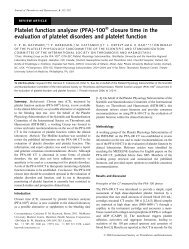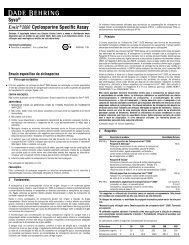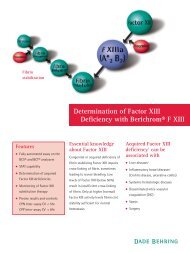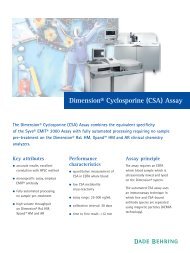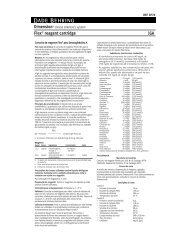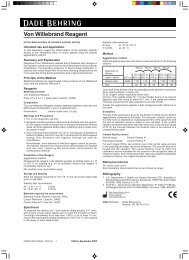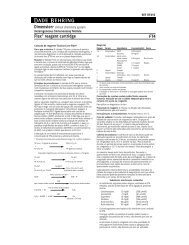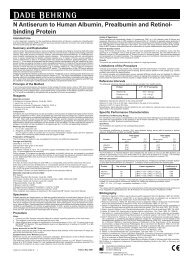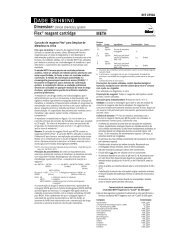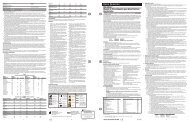Create successful ePaper yourself
Turn your PDF publications into a flip-book with our unique Google optimized e-Paper software.
Enzygnost * <strong>Anti</strong>-<strong>HBs</strong> <strong>II</strong><br />
Intended Use<br />
Enzyme immunoassay for the qualitative and quantitative detection of antibodies to hepatitis B<br />
surface antigen (<strong>HBs</strong>Ag) in serum and plasma.<br />
The enzyme immunoassay is processed using the BEP ® <strong>II</strong>, BEP ® <strong>II</strong>I and BEP ® 2000 ELISA<br />
processors. The test was developed for testing individual samples, not for pooled samples. The<br />
product is for in vitro diagnostic use only. The product is for in vitro diagnostic use only.<br />
Summary and Explanation<br />
Like hepatitis B surface antigen (<strong>HBs</strong>Ag), the anti-<strong>HBs</strong> antibody directed against the surface<br />
protein is an important parameter for the diagnosis of infection with hepatitis B virus (HBV) 1,2 .<br />
During the incubation period and in the acute phase of HBV infection, antibodies to <strong>HBs</strong>Ag are<br />
undetectable. In 90% of all cases these anti-<strong>HBs</strong> antibodies, which provide immunity, do not<br />
occur until late in convalescence approx. 3 to 4 months after the onset of the disease, when<br />
circulating <strong>HBs</strong>Ag can no longer be detected 3, 4 .<br />
This seroconversion, i.e. the transition from anti-<strong>HBs</strong> negative to positive, represents a very<br />
reliable parameter for diagnosing a past HBV infection, especially since approx. 10% of acutely<br />
infected patients in whom no <strong>HBs</strong>Ag can be detected in the early phase later become positive for<br />
anti-<strong>HBs</strong>. The anti-<strong>HBs</strong> test is therefore also suitable for the diagnosis for subclinical HBV<br />
infections 3, 4 .<br />
As a positive result for anti-<strong>HBs</strong> is indicative of past exposure to this antigen - either by HBV<br />
infection or by vaccination, the most important applications of the anti-<strong>HBs</strong> test are as follows:<br />
a) assessment of convalescence and, to a certain extent, also prognosis in patients infected with<br />
HBV (follow-up),<br />
b) serological investigations in the context of vaccination programmes (screening and<br />
immunization check-ups),<br />
c) epidemiological studies.<br />
Besides the qualitative detection of anti-<strong>HBs</strong>, the quantitative evaluation of anti-<strong>HBs</strong> has gained<br />
its own relevance with regard to the aspect of active immunization. According to a<br />
recommendation of the WHO, a person vaccinated with a hepatitis vaccine can be assumed to<br />
be protected against the infection if an anti-<strong>HBs</strong> concentration of > 10 IU/L can be detected in the<br />
serum or plasma. Booster vaccinations in time are recommended to guarantee that the values<br />
are not below this limit 5, 6, 7 .<br />
Patients found to have anti-<strong>HBs</strong> values < 100 IU/L after the completion of basic immunization<br />
require booster vaccination within one year (Recommendations of the Standing Vaccination<br />
Comittee of the Robert Koch Institute in Germany, October 1995).<br />
The necessity of a quantitative assessment is furthermore underlined by the fact that the<br />
duration of immunity is proportional to the attained levels of anti-<strong>HBs</strong>.<br />
Principle of the Method<br />
Enzygnost * <strong>Anti</strong>-<strong>HBs</strong> <strong>II</strong> is a one-step assay based on the sandwich principle. The antigen used<br />
for the solid phase and conjugate is human <strong>HBs</strong>Ag.<br />
Peroxidase-labelled <strong>HBs</strong>Ag binds to the <strong>HBs</strong>-specific antibodies contained in the sample. These<br />
bind to the <strong>HBs</strong>Ag bound to the surface of the microtitration plate (antigen sandwich).<br />
The unbound constituents are removed by washing and the bound enzyme activity of the<br />
conjugate is then determined. The enzymatic conversion of substrate and chromogen results in<br />
a blue colour. The reaction is terminated by the addition of Stopping Solution POD, producing a<br />
yellow colour. The intensity of the colour is proportional to the concentration of antibody in the<br />
sample. The results are quantified by calculation using the α-method or by comparison with a<br />
standard curve.<br />
OQNE G11 C0541 (906) H/R 2 Edition February 2004



